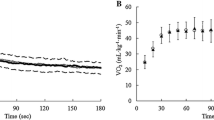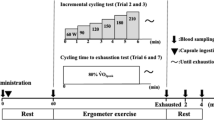Abstract
The purpose of this study was to determine if improved supramaximal exercise performance in trained cyclists following caffeine ingestion was associated with enhanced O2 uptake (\( \dot{V}{\text{O}}_{2} \) kinetics), increased anaerobic energy provision (accumulated O2—AO2—deficit), or a reduction in the accumulation of metabolites (for example, K+) associated with muscular fatigue. Six highly trained male cyclists (\( \dot{V}{\text{O}}_{2} \)peak 68 ± 8 mL kg−1 min−1) performed supramaximal (120% \( \dot{V}{\text{O}}_{2} \)peak) exercise bouts to exhaustion on an electronically braked cycle ergometer, following double-blind and randomized ingestion of caffeine/placebo (5 mg kg−1). Time to exhaustion (TE), \( \dot{V}{\text{O}}_{2} \) kinetics, AO2 deficit, blood lactate (La−), plasma potassium (K+), caffeine and paraxanthine concentrations were measured. Caffeine ingestion elicited significant increases in TE (14.8%, p < 0.01) and AO2 deficit (6.5%, p < 0.05). In contrast, no changes were observed in AO2 deficit at isotime, \( \dot{V}{\text{O}}_{2} \) kinetics, blood [La−] at exhaustion or peak [K+] following caffeine ingestion. However, [K+] was significantly reduced (13.4%, p < 0.01) during warm-up cycling immediately prior to the onset of the supramaximal bout for the caffeine trials, compared with placebo. It appears that caffeine ingestion is beneficial to supramaximal cycling performance in highly trained men. The reduced plasma [K+] during submaximal warm-up cycling may prolong the time taken to reach critical [K+] at exhaustion, thus delaying fatigue. Considering caffeine ingestion did not change \( \dot{V}{\text{O}}_{2} \) kinetics or isotime AO2 deficit, increases in absolute AO2 deficit may be a consequence of prolonged TE, rather than causal.



Similar content being viewed by others
References
Anderson C, Horne JA (2008) Placebo response to caffeine improves reaction time performance in sleepy people. Hum Psychopharmacol 23:333–336
Anselme F, Collomp K, Mercier B, Ahmaidi S, Prefaut C (1992) Caffeine increases maximal anaerobic power and blood lactate concentration. Eur J Appl Physiol Occup Physiol 65:188–191
Bangsbo J, Gollnick PD, Graham TE, Juel C, Kiens B, Mizuno M, Saltin B (1990) Anaerobic energy production and O2 deficit–debt relationship during exhaustive exercise in humans. J Physiol 422:539–559
Barstow TJ, Jones AM, Nguyen PH, Casaburi R (1996) Influence of muscle fiber type and pedal frequency on oxygen uptake kinetics of heavy exercise. J Appl Physiol 81:1642–1650
Bell DG, Jacobs I, Zamecnik J (1998) Effects of caffeine, ephedrine and their combination on time to exhaustion during high-intensity exercise. Eur J Appl Physiol Occup Physiol 77:427–433
Bell C, Kowalchuk J, Paterson D, Scheuermann B, Cunningham D (1999) The effects of caffeine on the kinetics of O2 uptake, CO2 production and expiratory ventilation in humans during the on-transient of moderate and heavy intensity exercise. Exp Physiol 84:761–774
Bell DG, Jacobs I, Ellrington K (2001) Effect of caffeine and ephedrine ingestion on anaerobic exercise performance. Med Sci Sports Exerc 33:1399–1403
Caputo F, Mello MT, Denadai BS (2003) Oxygen uptake kinetics and time to exhaustion in cycling and running: a comparison between trained and untrained subjects. Arch Physiol Biochem 111:461–466
Carter H, Pringle JS, Jones AM, Doust JH (2002) Oxygen uptake kinetics during treadmill running across exercise intensity domains. Eur J Appl Physiol 86:347–354
Clausen T, Flatman JA (1977) The effect of catecholamines on Na-K transport and membrane potential in rat soleus muscle. J Physiol 270:383–414
Demarle AP, Slawinski JJ, Laffite LP, Bocquet VG, Koralsztein JP, Billat VL (2001) Decrease of O2 deficit is a potential factor in increased time to exhaustion after specific endurance training. J Appl Physiol 90:947–953
Doherty M (1998) The effects of caffeine on the maximal accumulated oxygen deficit and short-term running performance. Int J Sport Nutr 8:95–104
Endo MY, Kobayakawa M, Kinugasa R, Kuno S, Akima H, Rossiter HB, Miura A, Fukuba Y (2007) Thigh muscle activation distribution and pulmonary VO2 kinetics during moderate, heavy, and very heavy intensity cycling exercise in humans. Am J Physiol Regul Integr Comp Physiol 293:R812–R820
Fraser SF, Li JL, Carey MF, Wang XN, Sangkabutra T, Sostaric S, Selig SE, Kjeldsen K, McKenna MJ (2002) Fatigue depresses maximal in vitro skeletal muscle Na(+)–K(+)-ATPase activity in untrained and trained individuals. J Appl Physiol 93:1650–1659
Fredholm BB, Battig K, Holmen J, Nehlig A, Zvartau EE (1999) Actions of caffeine in the brain with special reference to factors that contribute to its widespread use. Pharmacol Rev 51:83–133
Graham TE (2001) Caffeine and exercise: metabolism, endurance and performance. Sports Med 31:785–807
Graham TE, Helge JW, MacLean DA, Kiens B, Richter EA (2000) Caffeine ingestion does not alter carbohydrate or fat metabolism in human skeletal muscle during exercise. J Physiol (Lond) 529:837–847
Greer F, Grafton TE, Nagy LE (1997) Characterization of adenosine receptors in rat skeletal muscle. Can J Appl Physiol 22:23
Greer F, McLean C, Graham TE (1998) Caffeine, performance, and metabolism during repeated Wingate exercise tests. J Appl Physiol 85:1502–1508
Jackman M, Wendling P, Friars D, Graham TE (1996) Metabolic, catecholamine, and endurance responses to caffeine during intense exercise. J Appl Physiol 81:1658–1663
Koch JP, GWt Tusscher, Koppe JG, Guchelaar HJ (1999) Validation of a high-performance liquid chromatography assay for quantification of caffeine and paraxanthine in human serum in the context of CYP1A2 phenotyping. Biomed Chromatogr 13:309–314
Koga S, Shiojiri T, Kondo N (2005) Measuring VO2 kinetics: The practicalities. In: Jones AM, Poole DC (eds) Oxygen uptake kinetics in sport, exercise and medicine. Routledge, Abingdon, pp 39–61
Kovacs EM, Stegen J, Brouns F (1998) Effect of caffeinated drinks on substrate metabolism, caffeine excretion, and performance. J Appl Physiol 85:709–715
Lindinger M, Graham T, Spriet L (1993) Caffeine attenuates the exercise-induced increase in plasma [K+] in humans. J Appl Physiol 74:1149–1155
Lindinger M, Willmets R, Hawke T (1996) Stimulation of Na+, K(+)-pump activity in skeletal muscle by methyxanthines: evidence and proposed mechanisms. Acta Physiol Scand 156:347–353
Mansour TE (1972) Phosphofructokinase activity in skeletal muscle extracts following administration of epinephrine. J Biol Chem 247:6059–6066
McKenna MJ, Bangsbo J, Renaud J-M (2008) Muscle K+, Na+, and Cl disturbances and Na+–K+ pump inactivation: implications for fatigue. J Appl Physiol 104:288–295
Medbø JI, Jebens E, Vikne H, Refsnes PE, Gramvik P (2001) Effect of strenuous strength training on the Na-K pump concentration in skeletal muscle of well-trained men. Eur J Appl Physiol 84:148–154
Medbø JI, Mohn AC, Tabata I, Bahr R, Vaage O, Sejersted OM (1988) Anaerobic capacity determined by maximal accumulated O2 deficit. J Appl Physiol 64:50–60
Minahan C, Wood C (2008) Strength training improves supramaximal cycling but not anaerobic capacity. Eur J Appl Physiol 102:659–666
Mitsumoto H, DeBoer GE, Bunge G, Andrish JT, Tetzlaff JE, Cruse RP (1990) Fiber-type specific caffeine sensitivities in normal human skinned muscle fibers. Anesthesiology 72:50–54
Noakes TD (2000) Physiological models to understand exercise fatigue and the adaptations that predict or enhance athletic performance. Scand J Med Sci Sports 10:123–145
Ozyener F, Rossiter HB, Ward SA, Whipp BJ (2001) Influence of exercise intensity on the on- and off-transient kinetics of pulmonary oxygen uptake in humans. J Physiol 533:891–902
Pringle JSM, Doust JH, Carter H, Tolfrey K, Campbell IT, Jones AM (2003) Oxygen uptake kinetics during moderate, heavy and severe intensity ‘submaximal’ exercise in humans: the influence of muscle fibre type and capillarisation. Eur J Appl Physiol 89:289–300
Sabapathy S, Schneider DA, Comadira G, Johnston I, Morris NR (2004) Oxygen uptake kinetics during severe exercise: a comparison between young and older men. Respir Physiol Neurobiol 139:203–213
Santalla A, Lucia A, Perez M (2001) Caffeine Ingestion Attenuates the VO2 Slow Component during Intense Exercise. Jpn J Physiol 51:761–764
Schneider DA, Phillips SE, Stoffolano S (1993) The simplified V-slope method of detecting the gas exchange threshold. Med Sci Sports Exerc 25:1180–1184
Scott CB, Roby FB, Lohman TG, Bunt JC (1991) The maximally accumulated oxygen deficit as an indicator of anaerobic capacity. Med Sci Sports Exerc 23:618–624
Sjogaard G (1990) Exercise-induced muscle fatigue: the significance of potassium. Acta Physiol Scand Suppl 593:1–63
Weber CL, Schneider DA (2002) Increases in maximal accumulated oxygen deficit after high-intensity interval training are not gender dependent. J Appl Physiol 92:1795–1801
Williams BD, Plag I, Troup J, Wolfe RR (1995) Isotopic determination of glycolytic flux during intense exercise in humans. J Appl Physiol 78:483–490
Conflict of interest statement
The authors declare that they have no conflict of interest.
Author information
Authors and Affiliations
Corresponding author
Additional information
Communicated by Susan Ward.
Rights and permissions
About this article
Cite this article
Simmonds, M.J., Minahan, C.L. & Sabapathy, S. Caffeine improves supramaximal cycling but not the rate of anaerobic energy release. Eur J Appl Physiol 109, 287–295 (2010). https://doi.org/10.1007/s00421-009-1351-8
Accepted:
Published:
Issue Date:
DOI: https://doi.org/10.1007/s00421-009-1351-8




